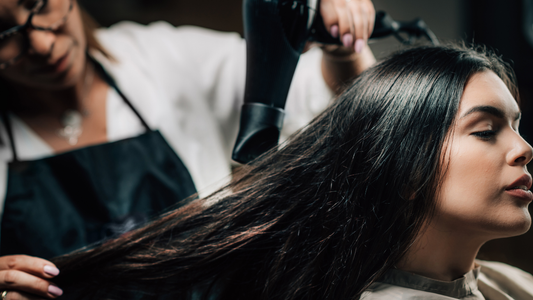Keratin treatments have become a popular option for achieving smooth, frizz-free hair. However, like any chemical-based beauty treatment, there is the potential for adverse reactions. While most people experience only the benefits of a keratin treatment, some individuals may encounter irritation, allergic reactions, or other side effects.
In this article, we’ll discuss the common types of reactions people may have to keratin treatments, provide step-by-step advice on how to respond if you experience any discomfort or side effects, and highlight how Kera Mane Keratin Hair Treatment minimizes the risk of adverse reactions by using a formaldehyde-free, gentle formula. We’ll also outline when it’s important to seek medical attention.
Understanding Keratin Treatment Reactions
Although keratin treatments are designed to enhance the appearance and manageability of hair, certain ingredients—such as harsh chemicals, preservatives, and fragrances—can sometimes cause reactions, particularly for individuals with sensitive skin, scalp conditions, or allergies.
Common Keratin Treatment Reactions:
- Skin Irritation: Redness, itching, or burning on the scalp, neck, or face may occur after the application of a keratin treatment. This can happen due to chemical sensitivity or contact with harsh ingredients like formaldehyde or preservatives.
- Allergic Reactions: In rare cases, people may experience an allergic reaction to specific ingredients in the treatment, leading to swelling, hives, or difficulty breathing.
- Eye Irritation: Vapors or fumes released during the keratin application process, especially if heat is applied, can cause eye irritation, watering, or burning sensations.
- Respiratory Issues: In treatments that contain formaldehyde or other strong chemicals, some individuals may experience respiratory symptoms such as coughing, wheezing, or shortness of breath if fumes are inhaled.
- Hair Damage: Overuse of keratin treatments or improper application may lead to dryness, breakage, or even hair loss, especially for those with already weakened or damaged hair.
What to Do If You Experience a Reaction to a Keratin Treatment
If you experience any adverse reaction to a keratin treatment, it's important to act quickly and follow the appropriate steps to minimize discomfort and prevent further complications. Here are steps you can take, depending on the severity of the reaction:
1. Rinse Your Hair Immediately
- Why It’s Important: If you experience any discomfort, itching, or burning sensations during or after the treatment, the first step is to thoroughly rinse your hair to remove any remaining product. This can help reduce irritation and stop the chemicals from further affecting your scalp or skin.
- How to Do It: Use lukewarm water to rinse your hair for at least 10 minutes, making sure to wash out all of the treatment. Avoid using hot water, as it can exacerbate irritation. If possible, use a gentle, sulfate-free shampoo to cleanse the scalp and remove product residue.
2. Use a Mild, Cooling Treatment for Scalp Irritation
- Why It’s Important: If your scalp feels irritated or inflamed, applying a soothing treatment can help reduce discomfort and calm the skin. Look for ingredients that are cooling and anti-inflammatory, such as aloe vera, chamomile, or cucumber extract.
- How to Do It: Apply a gentle, natural cooling treatment directly to the affected area of your scalp. Aloe vera gel or cucumber slices can provide relief. Avoid using any additional products that may contain harsh chemicals, as they could further irritate the skin.
3. Apply Cold Compresses for Swelling or Redness
- Why It’s Important: If your skin becomes red or swollen following the treatment, applying a cold compress can help reduce inflammation and discomfort.
- How to Do It: Wrap a few ice cubes in a clean cloth or towel and gently press it against the irritated area for 10-15 minutes. You can repeat this process as needed to reduce swelling.
4. Take an Antihistamine for Allergic Reactions
- Why It’s Important: If you experience symptoms of an allergic reaction—such as hives, itching, or swelling—it’s important to address these symptoms quickly. An over-the-counter antihistamine can help reduce allergic symptoms and provide relief.
- How to Do It: Follow the dosage instructions on the packaging of an over-the-counter antihistamine, such as Benadryl (diphenhydramine) or Claritin (loratadine). If your symptoms persist or worsen, seek medical attention.
5. Ventilate the Area to Avoid Respiratory Issues
- Why It’s Important: If you notice respiratory symptoms such as coughing, wheezing, or difficulty breathing during or after your keratin treatment, it could be due to fumes or vapors from the product. Ensuring proper ventilation can help minimize exposure.
- How to Do It: Open windows and doors to improve air circulation in the room. If you are indoors and ventilation is limited, step outside for fresh air to alleviate symptoms. If you continue to experience respiratory distress, seek medical help immediately.
6. Avoid Using Heat or Styling Products
- Why It’s Important: If your scalp or skin feels irritated after the treatment, avoid using heat styling tools (like flat irons, blow dryers, or curling irons) or other hair products that could aggravate the irritation.
- What to Do Instead: Let your hair air-dry naturally, and give it time to recover before applying any styling products. Avoid using alcohol-based or heavy styling products, as they can cause further dryness or irritation.
When to Seek Medical Attention
While mild irritation and discomfort can often be treated at home, certain symptoms may indicate a more serious reaction that requires medical attention. If you experience any of the following, it’s important to seek professional help immediately:
- Severe Allergic Reactions: If you notice symptoms such as difficulty breathing, swelling of the face or throat, dizziness, or chest pain, this could indicate a severe allergic reaction (anaphylaxis) and requires emergency medical attention. Call 911 or visit the nearest emergency room.
- Persistent Skin Irritation: If skin irritation (such as redness, itching, or burning) persists for more than 24 hours or worsens after treatment, consult with a dermatologist or healthcare professional.
- Prolonged Respiratory Symptoms: If you continue to experience respiratory issues such as coughing, wheezing, or shortness of breath even after moving to a well-ventilated area, it’s important to seek medical care to prevent further complications.
How Kera Mane Keratin Hair Treatment Reduces the Risk of Reactions
At Kera Mane, we understand the importance of safety when it comes to hair treatments. That’s why our Kera Mane Keratin Hair Treatment is formulated to minimize the risk of adverse reactions by using a gentle, formaldehyde-free formula that is suitable for a wide range of hair types and sensitivities.
What Makes Kera Mane Safer:
- Formaldehyde-Free Formula: Unlike many traditional keratin treatments that use formaldehyde—a chemical known to cause skin irritation, respiratory issues, and other side effects—Kera Mane is completely free of formaldehyde. This makes it a safer option for both home and salon use.
- Natural Ingredients: Kera Mane is enriched with natural, nourishing ingredients like argan oil and coconut oil, which help soothe and protect the hair and scalp during the treatment process.
- Low-Risk for Irritation: Our formula is designed to be gentle on the scalp, reducing the risk of irritation or discomfort. We prioritize ingredients that are less likely to cause adverse reactions while still delivering professional-grade results.
- No Harsh Fumes: Without the use of formaldehyde, Kera Mane does not produce the harsh fumes associated with traditional keratin treatments, reducing the risk of respiratory issues and eye irritation during application.
Preventing Reactions: Tips for a Safe Keratin Treatment Experience
To reduce the risk of experiencing an adverse reaction to a keratin treatment, here are some additional preventive measures you can take:
1. Perform a Patch Test
- Why It’s Important: Before applying a keratin treatment to your entire head, it’s a good idea to perform a patch test to check for any allergic reactions or sensitivities to the product.
- How to Do It: Apply a small amount of the product to a discreet area of skin, such as behind your ear or on the inside of your forearm. Wait 24-48 hours and check for any signs of redness, itching, or swelling. If you experience a reaction, avoid using the product on your scalp and hair.
2. Use Proper Ventilation
- Why It’s Important: Ensuring adequate ventilation during the keratin treatment process can help prevent respiratory issues, especially if you’re sensitive to fumes or vapors.
- How to Do It: Always perform the treatment in a well-ventilated area with open windows or fans to allow fresh air to circulate. Avoid confined spaces where fumes could build up.
3. Choose a Formaldehyde-Free Treatment
- Why It’s Important: Formaldehyde is a common cause of skin, eye, and respiratory irritation during keratin treatments. Opting for a formaldehyde-free option like Kera Mane Keratin Hair Treatment can significantly reduce the risk of these reactions.
Conclusion
While keratin treatments can provide smooth, sleek, and frizz-free hair, it's important to be aware of potential reactions and know how to address them if they occur. By following the steps outlined in this article—such as rinsing your hair, using cooling treatments, and seeking medical help when necessary—you can manage and minimize the effects of any adverse reactions.
Choosing a safe, formaldehyde-free product like Kera Mane Keratin Hair Treatment can greatly reduce the risk of irritation, allergies, or respiratory issues while still delivering professional-quality results. By taking preventive measures and following proper aftercare, you can enjoy the benefits of a keratin treatment with peace of mind.




